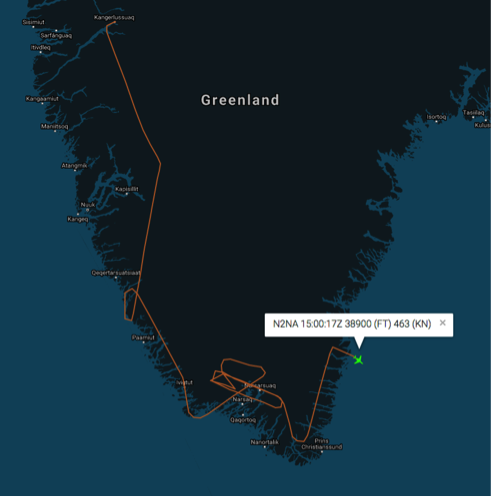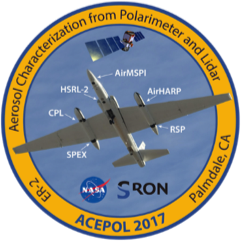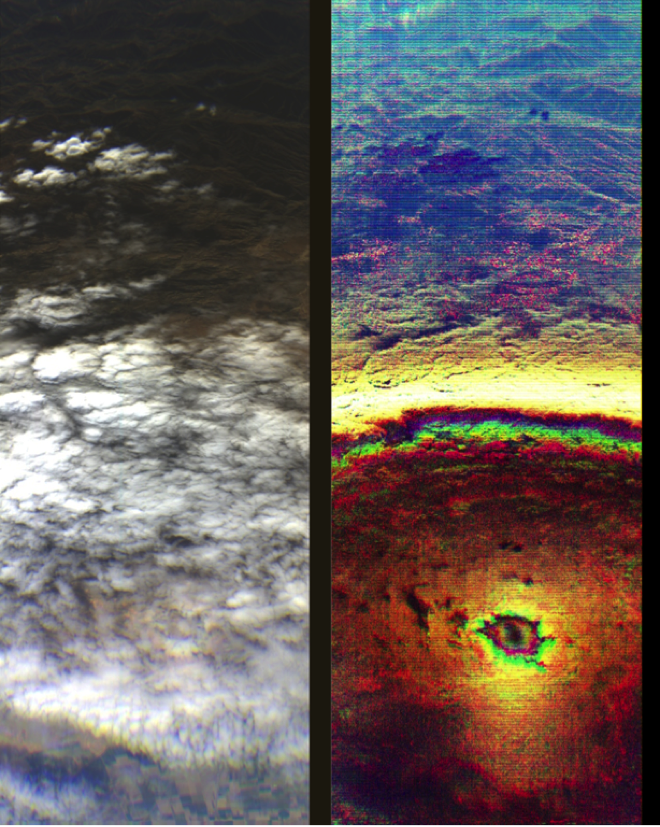The Ka-band radar (GLISTIN-A) is more than half way through its Oceans Melting Greenland (OMG) Greenland deployment aboard the JSC G-III. So far we have acquired 50 out of 81 flight lines in 6 science flights.
You are here
News
On 6 March, GLISTIN- A flew from Bangor, acquired radar data from 3 science flight lines, and landed at Kanger, Greenland.
On 7 March, GLISTIN-A flew 10 science flight lines and on 8 March, 12 science lines were flown. Sunday, 11 March was a down day for JSC crew change. This week, OMG GLISTIN-A flew a total of 32 of 84 science flight lines

GLISTIN-A Flight track for 7 March
On Saturday, 10 March, GLISTIN-A flew from Kanger, Greenland, acquired 7 lines over Southern Greenland and landed at Keflavik, Iceland.

Flight track for 10 March
The following press release was issued on 2 February, 2018:
The NASA Langley Atmospheric Sciences Data Center (ASDC) and Jet Propulsion Laboratory (JPL) announce the public release of Version 001 of the Airborne Multiangle SpectroPolarimetric Imager (AirMSPI) Level 2 Cloud Droplet Size and Cloud Optical Depth Data Product for the ObseRvations of Aerosols above CLouds and their intEractionS (ORACLES) flight campaign.
AirMSPI flies in the nose of NASA's high-altitude ER-2 aircraft. The instrument was built by JPL and the University of Arizona under NASA’s Instrument Incubator and Airborne Instrument Technology Transition Programs, and is aimed primarily at remote sensing of the amounts and microphysical properties of aerosols and clouds.
The AirMSPI Level 2 Cloud Droplet Size and Cloud Optical Depth Data Product contains a droplet size distribution (DSD), parameterized by an effective radius (reff) and effective variance (veff) of a gamma size distribution, as well as a spatially resolved cloud optical depth (COD) at 470, 660 and 865 nm. These L2 products are derived from L1B2 radiometric and polarimetric data taken in the instrument's continuous sweep mode with 25 m spatial sampling. Along with the L2 products, their retrieval uncertainties are reported, as propagated from the relevant uncertainties in instrument radiometry and polarimetry. Files are distributed in NetCDF4 format.
This release of AirMPSI L2 data contains targets over ocean acquired in sweep mode during the ORACLES flight campaign, including the check-out and transit flights. ORACLES was based out of Walvis Bay, Namibia and focused on the South Atlantic Ocean off the coast of Namibia and Angola. AirMSPI L2 data were acquired from 3 August to 29 September, 2016. More details about the ORACLES campaign and AirMSPI participation can be found at https://espo.nasa.gov/oracles.
Information about these products, details about product quality, and mechanisms to access the data can be found under AirMSPI Data and Information at the ASDC website, https://eosweb.larc.nasa.gov/.
The Classic Airborne Visible and Infrared Imaging Spectrometer (AVIRIS-C) and Portable Remote Imaging Spectrometer (PRISM) are deployed with the NASA ER2 to Marine Corps Base Hawaii (MCBH) on the Island of Oahu. The mission has conducted most of the flights for Coral Reefs targets and has had successful day/night ASTER underpasses for studying the volcano and volcanic gas plume.
The Classic Airborne and Visible Infrared Imaging Spectrometer (AVIRIS-C) and the Portable Remote Imaging Spectrometer (PRISM) are both deployed on the NASA ER2 to Marine Corps Base Hawaii (MCBH) on Oahu. The campaign is the HyspIRI HyTES Hawaii Campaign (H3C) and there have been collections over both the Big Island Volcano targets and coral reefs in the main island chain.
AirMSPI took part in the Aerosol Characterization from Polarimeter and Lidar (ACEPOL) field campaign, which took place from 19 October to 9 November with the NASA ER-2 high altitude research aircraft flying out of the Armstrong Flight Research Center (ARFC) in Palmdale, CA.

ACEPOL is a collaborative effort among the NASA Aerosol-Cloud-Ecosystems (ACE) pre-formulation study, the Cloud-Aerosol Lidar and Infrared Pathfinder Satellite Observation (CALIPSO) project, and the Netherlands Institute for Space Research (SRON). The objective of ACEPOL is to assess the capabilities of proposed future instruments to answer fundamental science questions associated with aerosols, clouds, air quality, and global ocean ecosystems. ACEPOL also acquired reference data for the ongoing CALIPSO satellite mission. ACEPOL results are relevant to future satellite missions such as joint European Space Agency (ESA) – Japan Aerospace Exploration Agency (JAXA) Japanese Earth Clouds, Aerosol and Radiation Explorer (EarthCARE), the NASA Plankton, Aerosol, Cloud, ocean Ecosystem (PACE) mission, and JPL’s Multi-Angle Imager for Aerosols (MAIA) Earth Ventures Instrument. In particular, data acquired during ACEPOL will be used to assess remote sensing retrievals of aerosol and cloud microphysical and optical parameters and aerosol and cloud layer heights. ACEPOL results will further enable the development of novel aerosol and cloud retrieval algorithms by utilizing the full information content provided by the combination of active and passive remote sensing instruments.

(Left) AirMSPI red/green/blue image of liquid water clouds over land (Right). Same image in degree of linear polarization from the near-infrared/red/blue bands. The small, circular feature is the glory and the larger, bright white arc is the cloudbow. The size, location, and brightness of these features provide information on cloud microphysics.
ASO continued snow-off surveys of the Feather watershed and American watershed last week. Sub-basins surveyed in the South Fork of the American basin include Ice House, Union Valley, and Loon Lake. Sub-basins surveyed in the North Fork of the American basin include French Meadows and Hell Hole reservoir.
On Thursday, 26 October, Miles Obrien from the PBS News Hour filmed a story on the California Airborne Methane Survey. It was a successful filming, and he was able to fly with the team during data collections and interview Riley Duren and Andrew Thorpe during the flight. As part of the story, there will be filming of the AVIRIS-NG King Air by AFRC in the next week to collect video of the AVIRIS-NG aircraft from the AFRC T-34. The California Airborne methane Survey is winding down, and the AVIRIS-NG has some collections over the Sacramento Delta in the next week
The L-band radar aboard the Armstrong C-20A aircraft (NASA502) is nearly complete with three weeks of California local flights to monitor San Andreas Fault activities and Sacramento Delta levee health. We are also studying landslide activities in Slumgullion, CO by observing the study site once every week over a 3-week period
ASO began a snow-off survey of the Feather river watershed in partnership with the CA Department of Water Resources last week. The Feather river watershed encompasses 3,500 square miles of land and flows into Lake Oroville formed by Oroville Dam.
On Monday, 23 October, OMG‘s Airborne eXpendable Conductivity, Temperature, and Depth, (AXCTD) C-130 continued dropping AXCTD probes on the South West side of Greenland. By the end of the science flight, OMG AXCTD dropped over 30 AXCTDs and concluded the 2017 AXCTD science mission. In eight OMG AXCTD science flights, OMG dropped over 240 AXCTDs.
